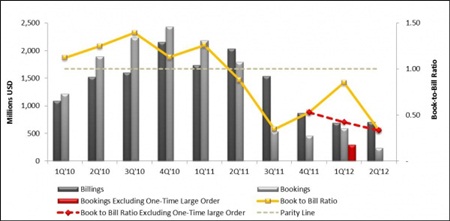PV Book-to-bill ratio of just 0.33 measured in second quarter of 2012,with SEMI seeing no near-term recovery.
 Heading south:the global PV equipment market
Heading south:the global PV equipment market
The market for photovoltaics manufacturing equipment continued to decline in the second quarter of 2012,as the industry continued to suffer from a global oversupply of cells and the looming specter of trade protectionism.
The latest figures compiled by Semiconductor Equipment and Materials International(SEMI)and the German Engineering Federation(VDMA)showed worldwide bookings of only$235 million for the three months ending June 30'down from the prior quarter and the lowest figure reported over at least the past ten quarters.
Worldwide billings were up very slightly,to$706 million,but that figure represents a 65%decline compared with the second quarter of 2011.
The scarcity of orders means that the key book-to-bill ratio fell to just 0.33,indicating a fifth consecutive period of contracting demand since the opening quarter of 2011.
SEMI said in a statement:'Overcapacity and falling prices continue to plague the PV industry,and the extremely challenging environment for PV equipment suppliers worldwide is likely to persist due to low booking activities from PV manufacturers,coupled with no near-term signs of recovery.'As a result,says the organization,it is vital that equipment suppliers focus on long-term strategies to withstand the severe market decline.
VDMA urges free trade
Market confidence will also have been knocked following the recent decision by the European Commission(EC)to follow the US and launch an anti-dumping investigation into imports of Chinese-made PV modules,cells and wafers,after a complaint led by the Germany-based panel maker SolarWorld.
The VDMA's photovoltaic equipment division had previously issued a policy paper in which it expressed its concern about the impact that any protectionist measures would have on the industry.
'The industry should rather concentrate on its strengths and pave the way towards competitiveness of PV in Germany,'the VDMA wrote in its paper.'In general protectionism harms the machinery industry.'The last thing the German PV equipment industry needs now is a lengthy and unprofitable conflict with one of its key markets,'it added,suggesting that any punitive tariffs'which could not be applied by the EC until next year at the very earliest'would create more uncertainty and shake the investment confidence of solar cell and module manufacturers around the world.
Echoing SEMI's call for long-term strategic moves,the VDMA also says that PV equipment firms must concentrate on technology leadership even more intensively than in the past.
One area of photonics that could benefit from such a long-term focus could be lasers for materials processing,which can be used in a variety of ways to improve PV cell and panel efficiencies,but which do not at present account for a great deal of the PV equipment market.
Suntech slims cell operations
Evidence of the declining confidence of cell and module makers mounted earlier this week when Suntech Power,ranked as the leading crystalline silicon PV module maker last year,confirmed that it had closed a portion of its solar cell manufacturing facility in Wuxi,China.
David King,Suntech's CEO,said in a statement:"In light of the preliminary US anti-dumping tariff,the European anti-dumping investigation,and oversupply of solar modules,we have decided to right-size our production capacity and continue to optimize our organization.'
That'optimization'will result in closed factories and laying off an expected 1500 employees in China,with the measures expected to reduce operating expenses by some 20%in fiscal year 2012,compared with 2011.
Following that restructuring,Suntech says that its operational solar cell capacity will be reduced to 1.8GW temporarily,although module capacity will remain at 2.4GW and wafer capacity will remain at 1.6GW.
The moves should substantially improve utilization rates at Suntech's solar cell production facilities,while panel costs should also improve as the company will be using its highest-efficiency,lowest-cost manufacturing facilities as a priority.





